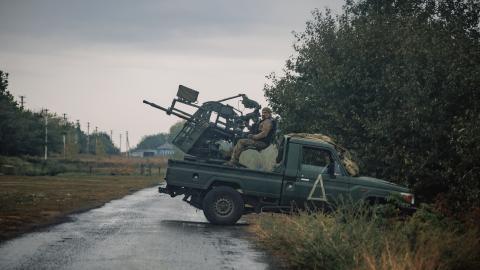Below Senior Fellow Can Kasapoğlu offers a military situation report about the war in Ukraine.
Executive Summary
• The Ukrainian military continued to conduct tactical offensives in Kharkiv Oblast and the Russian region of Kursk.
• The Kremlin’s forces inched closer to capturing the Ukrainian town of Vuhledar.
• Ukraine launched multiple long-range salvos against Russian ammunition depots.
• The Ukrainian Air Force is reportedly set to receive the AGM-154, a potent long-range weapon, as part of a new military assistance package from the United States.
1. Battlefield Assessment
The battlefield geometry of Russia’s war on Ukraine remains stable at the strategic level. At the tactical level, however, dynamic clashes raged last week in both Ukraine and Russia. Notably, Ukraine launched a series of promising counteroffensives that have inspired optimism about Kyiv’s military capabilities. To disrupt the Kremlin’s offensive operations in the Russian region of Kursk, the Ukrainian military conducted a rapid tactical salient in the area of Glushkovo. Open-source intelligence suggests that Ukraine’s 95th Air Assault Brigade and 225th Battalion, both elite units, have been running the operation at a pressing tempo. Major territorial changes in Kursk are currently unlikely, and it is becoming more apparent that the Ukrainian Armed Forces plan to stay in the region until the end of the war.
In Kharkiv Oblast, detachments from Kyiv’s Main Directorate of Intelligence (GUR) played a crucial role in recapturing an aggregate plant in the town of Vovchansk. Ukraine’s defense intelligence chief, General Kyrylo Budanov, announced the successful completion of the operation. Ukrainian press sources claim that this significant achievement was the result of intensive urban warfare in the Vovchansk sector. Russian forces also continued to conduct tactical offensives. Declassified military intelligence from the United Kingdom indicated that Russian formations are now pushing westward from the village of Pishchane toward the eastern bank of the Oskil River. A position on the river would offer a natural defensive barrier that could help Russia stabilize the front. The Kharkiv sector also witnessed intense aerial bombardment in recent days.
The eastern front, meanwhile, continues to hang in the balance because of a dangerous Russian offensive push. In the town of Chasiv Yar, high-tempo warfighting continued despite few changes in territory. As previous editions of this report have noted, the Ukrainian military is fighting bravely to maintain control of the cities of Toretsk and Pokrovsk, where the Russian campaign has been on a firm offensive footing for weeks. In eastern Ukraine, Russian armored and mechanized formations have undertaken relatively large maneuver warfare efforts. This is notable because small units and flexible infantry detachments have dominated the recent phases of the war.
The most alarming developments for Kyiv occurred in Vuhledar. The Russian military reached Ukrainian forces’ last lines of defense and encircled most detachments of the Ukrainian 72nd Mechanized Brigade, which is running defensive combat operations. For years, Ukrainian troops have heroically defended the town, but the fall of Vuhledar may be imminent.
2. Ukraine Targets Russian Ammunition Depots
The Ukrainian Armed Forces have initiated a campaign to systematically target Russian ammunition depots, attacking the Tikhoretsk arms depot in Krasnodar Krai last week. The depot, one of the largest in Russia, was home to some 2,000 tons of weapons and munitions, reportedly including KN-23 tactical ballistic missiles transferred from North Korea. Visuals of heavy damage and massive fires at the site suggest that Ukraine dealt a significant blow to Russia’s military capabilities.
Ukraine also unleashed a drone swarm on the Toropets ammunition depot in the Russian region of Tver some 310 miles from Ukraine. That depot held more than 30,000 tons of ammunition, and the explosion caused by Ukraine’s strike registered a 2.7 on the Richter scale. Open-source satellite imagery showcased the catastrophic destruction at both impact sites.
Some analysts have concluded that Ukraine employed its new Palianytsia drone in these strikes. Kyiv has previously used the drone, which is equipped with a turbojet engine and a destructive warhead, to strike occupied Crimea.
3. The Ukrainian Air Force Prepares to Receive the AGM-154 Joint Standoff Weapon
Ukraine is reportedly set to receive the AGM-154, also known as the Joint Standoff Weapon (JSOW), as part of a $375 million military aid package from the United States, likely the final presidential drawdown package before the end of the fiscal year. Military assistance packages under presidential drawdown authority pull weapons from existing stockpiles to ensure faster delivery. The AGM-154 will significantly enhance the Ukrainian Air Force’s arsenal and provide its growing fleet of F-16 fighter aircraft with a potent new weapon. With an operational range of roughly 70 miles, a small radar signature designed to stress air defenses, and advanced guidance and targeting systems, the AGM-154 offers Kyiv a significant capability boost. While less formidable than the longer-range AGM-158 stealth missile Ukraine has long sought, the AGM-154 can be used effectively in a variety of combat scenarios. The precise variant of the munition Washington will provide Kyiv has not yet been revealed. But the weapon can carry both cluster and unitary warheads as well as ordnance that can penetrate fortified targets.
The AGM-154 is not without its flaws. To reach its maximum 70-mile range, it requires a high-altitude release; when released at lower altitudes, the weapon loses range. To contend with Russia’s advantage in the skies and long-range surface-to-air missile (SAM) arsenal, the Ukrainian Air Force often flies brief, low-altitude combat sorties. It is therefore unclear whether Ukraine’s AGM-154s will be able to strike targets from their full 70-mile range.
Nonetheless, the weapon brings significant advantages. It possesses considerable capabilities against electronic warfare measures, a crucial aspect of the ongoing war. Moreover, since the weapon is compatible with Kyiv’s new F-16s, the Ukrainian Air Force will not have to use technical workarounds to deploy the missile. This is an advantage compared to integrating Western arms into Russian or Soviet-vintage MiG-29 and Su-27 combat aircraft systems.




















